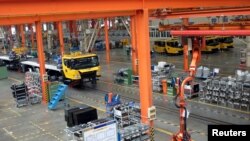Global manufacturing activity remained stuck in a rut last month with factory output from Asia to Europe barely improving as producers struggled to bring in new orders, surveys released on Wednesday showed.
Speculation has hardened in recent weeks that the U.S. Federal Reserve will raise interest rates in the next few months which, coupled with concerns about China and a possible British exit from the European Union, has knocked confidence.
The world economy will meander along at its slowest pace since the financial crisis for a second year in a row in 2016 as it is ensnared in a "low-growth trap", the OECD said on Wednesday, urging governments to boost spending.
Having fired another salvo in its battle to drive up growth and inflation in the euro zone earlier this year, European Central Bank President Mario Draghi in April called on governments to help get the region's sluggish economy on a more solid footing.
Yet, despite the ultra-loose monetary policy, euro zone manufacturing activity remained lacklustre in May, supporting the view that strong economic growth in the first quarter did not carry through to the second.
"This reinforces the idea things are going okay; it's not a disaster, but clearly there are no obvious signs that the big lift we saw in Q1 is going to be sustained," said Ben May at Oxford Economics. "Industry will be a bigger drag on growth in Q2 so we will see a slow down in GDP growth in the eurozone."
British factory growth was minimal at best in May and activity in Asia also failed to speed up as the region's export-driven businesses struggled for new orders from an overall lackluster global economy.
"The picture is pretty muted in Asia, both in terms of exports and factory activity," said Su Sian Lim, Southeast Asia economist at HSBC in Singapore.
Similarly, U.S. factory activity grew only marginally last month, Institute for Supply Management data due later on Wednesday are expected to show.
Holding pattern
Markit's final manufacturing Purchasing Managers' Index (PMI) for the euro zone dipped to a three-month low of 51.5 from April's 51.7, in line with a flash reading. Anything above 50 indicates growth.
A sub-index measuring output, which feeds into a composite PMI due Friday that is seen as good guide to growth, also fell.
Gross domestic product in the bloc grew 0.5 percent in the first quarter, figures showed last month, but is expected to expand just 0.3 percent this quarter, according to a May Reuters poll.
Britain's growth pace slowed in the first three months of the year and many economists expect further weakening in the second quarter. The Bank of England has said a vote to leave the EU could even tip the economy into recession.
Britons vote on June 23 whether or not to remain in the EU and recent data showed business investment fell in annual terms for the first time in three years as uncertainty over the referendum weighed on sentiment.
The Markit/CIPS manufacturing PMI for Britain rose more than expected but came in only just above the 50 level.
"This data is further evidence that businesses are holding off on hiring/investment decisions prior to the referendum on EU membership," said James Smith at ING.
China's official PMI was only fractionally positive at 50.1, though it was the third straight month of improvement. The survey also revealed new orders slowed and export orders stalled.
A private Caixin/Markit PMI, focusing on smaller companies, made sorrier reading for global firms reliant on China's giant market for everything from consumer items, to cars and commodities. It showed conditions deteriorated for a 15th straight month.
China's economy grew by 6.7 percent in the first quarter - its slowest since 2009, and there are nagging doubts about the authorities' ability to engineer a turnaround without piling on dangerous amounts of debt.
In Japan, factories grappling to recover from the earthquakes in the southern manufacturing hub of Kumamoto were also knocked by a contraction in external demand.
The Markit/Nikkei Japan PMI showed the fastest contraction in three years.
The yen's recovery to an 18-month high against the dollar last month has also clouded the outlook for Japan's exporters.
Elsewhere in Asia, conditions were patchy at best. Even in India, the world's fastest-growing big economy, manufacturing activity increased at a tepid pace as output growth softened for the second month in a row.
South Korea's manufacturing activity improved slightly last month, but more alarmingly, separate data showed exports unexpectedly fell 6.0 percent last month with shipments to China, its biggest customer, contracting 9.1 percent on-year.
Australia, at least, was faring better, with data released earlier in the day showing the economy accelerating at its fastest annual pace in three years in the first quarter.








